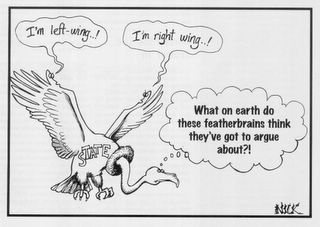 Political Spectrum, n. ie., that on which libertarians are not!
Political Spectrum, n. ie., that on which libertarians are not! Because of the abysmally low capacity for intellectual abstraction among philosophically illiterate politicians, journalists and political science graduates, however, it is seemingly impossible to shake off the label “right wing” even when irrefutable evidence is offered that the label is wrong. Therefore, it becomes necessary to point out periodically that “libertarians are neither left nor right wing.”
Leaving aside its historical origins, the spectrum as commonly understood nowadays is a one-dimensional line that places communism on the extreme left (out to the west), fascism on the extreme right (out to the east), with gradations of democratic versions of each in between -- something whose usefulness is close to zero, except for those with minds as one-dimensional as the left-right spectrum itself.
 Libertarians maintain that all philosophies on this one-dimensional spectrum sanction coercion; that the differences are merely of degree not of principle; that it matters not whether coercion is initiated by a majority or by a dictator – it is still coercion, to which we are opposed in whatever guise it is practised. In short, the traditional one-dimensional spectrum fails because it excludes from discussion the full spectrum of political freedom. (And this is perhaps one reason for the spectrum's continued popularity.)
Libertarians maintain that all philosophies on this one-dimensional spectrum sanction coercion; that the differences are merely of degree not of principle; that it matters not whether coercion is initiated by a majority or by a dictator – it is still coercion, to which we are opposed in whatever guise it is practised. In short, the traditional one-dimensional spectrum fails because it excludes from discussion the full spectrum of political freedom. (And this is perhaps one reason for the spectrum's continued popularity.)To lump libertarians in with the extreme right – with fascists, xenophobes, religious bigots etc. – is just as ignorant as it would be to call libertarians communists.
Another division of ideologies sometimes suggested is to place the total state on the left – communism and fascism – and the total absence of the state – anarchy, on the right, with gradations of statism in between. Thus: Communism/fascism democratic socialism/welfare state/mixed economy capitalism/limited constitutional government/individual freedom anarchy. But even this division is artificial, since anarchy also permits coercion without legal restraint, and must inevitably lead to some institutionalised form of it.
 If you really must simplify everything in this fashion, then a more meaningful arrangement is to make the traditional spectrum two-dimensional rather then one-dimensional by placing another line across the existing left-right one that goes north-south, heading down to authoritarianism at the bottom pole and up to freedom, sunshine and libertarianism at the top pole. At the four points of the compass then you would have Lenin, Mussolini and Winston Peters to the south; left-liberals like Gandhi, Ralph Nader and Nandor Tanczos to the west; and conservatives such as Margaret Thatcher, Rush Limbaugh and Ian Wishart to the east. Libertarians of course join Thomas Jefferson, James Madison and P.J. O'Rourke at the top of the world.
If you really must simplify everything in this fashion, then a more meaningful arrangement is to make the traditional spectrum two-dimensional rather then one-dimensional by placing another line across the existing left-right one that goes north-south, heading down to authoritarianism at the bottom pole and up to freedom, sunshine and libertarianism at the top pole. At the four points of the compass then you would have Lenin, Mussolini and Winston Peters to the south; left-liberals like Gandhi, Ralph Nader and Nandor Tanczos to the west; and conservatives such as Margaret Thatcher, Rush Limbaugh and Ian Wishart to the east. Libertarians of course join Thomas Jefferson, James Madison and P.J. O'Rourke at the top of the world.In the New Zealand context, the resulting diamond-shaped spectrum would look like this.
However and all in all, to paraphrase W.C. Fields, libertarians would rather be in Philadelphia. In 1776. And since the view of the state-citizen relationship expressed in the US Declaration of Independence doesn’t seem to have a comfortable place anywhere on the conventional Left-Right spectrum, it behoves us to leave those on it to quibble over who is to coerce whom, to what extent and why, while we get on with the business of promoting freedom – accepting with reluctance that in the meantime we shall undoubtedly have to put up with ignoramuses calling us “right wing.”
By their ignorance may ye know them.
LINKS: Left? Right? A plague on you both - Peter Cresswell
NZ's political spectrum - Peter Cresswell
Just how solid is that center? - Washington Post
Nolan Chart - Wikipedia
Cue Card Libertarianism - Introduction - Not PC
TAGS: Cue_Card_Libertarianism, Politics, Libertarianism, History
1 comment:
I have come across a fascinating Canadian web site http://www.politicalcompass.org/nz2011 which also provides a very credible, certainly constructive political self-analysis online questionnaire. It positions political outlook in the political space the various political parties occupy and seems to be able to identify Libertarian tendency quite acurately.
Post a Comment